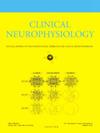Corticomotor excitability of the pelvic floor muscles in females: Characteristics of motor evoked potentials and test–retest reliability
IF 3.7
3区 医学
Q1 CLINICAL NEUROLOGY
引用次数: 0
Abstract
Objectives
To (1) design an efficient TMS protocol to elicit motor evoked potentials (MEPs) from female pelvic floor muscles (PFMs), (2) describe the characteristics of PFM MEPs and silent periods (SPs), (3) compare PFM MEP characteristics with nearby muscles and (4) determine the test–retest reliability of PFM MEP characteristics and SP duration.
Methods
Through a cross-sectional, observational design, adult females were tested at two sessions separated by one week. Single-pulse TMS was delivered over the motor cortex and motor responses were recorded from three PFMs, the lateral abdominal wall (LAW) and the hip adductors (ADD). MEP characteristics were compared among the PFMs and with those from the ADD and LAW. Test-retest reliability was examined using intra-class correlation coefficients (ICCs).
Results
Nearly all participants (n = 40/41) exhibited measurable SPs in the pubovisceralis and at least one other PFM. PFM MEPs exhibited shorter onset latencies than those of ADD and LAW. ICCs ranged from good to excellent, except for peak latency, which was poor. Yet all measures displayed high between-participant variance.
Conclusion
Investigating reliable TMS-induced motor responses in the PFMs of females is achievable using our protocol.
Significance
Our findings highlight the possibility of extending TMS applications to investigate changes in corticomotor excitability that may contribute to conditions that are associated with high PFM tone, such as vulvovaginal pain.
女性骨盆底肌肉的皮质运动兴奋性:运动诱发电位的特征和重测信度
目的:(1)设计一种有效的经颅磁刺激方案,以诱发女性盆底肌(PFMs)的运动诱发电位(MEP),(2)描述盆底肌MEP和沉默期(SPs)的特征,(3)将盆底肌MEP特征与附近肌肉进行比较,(4)确定盆底肌MEP特征和SP持续时间的重测可靠性。方法采用横断面观察设计,对成年女性进行间隔一周的两次测试。单脉冲经颅磁刺激通过运动皮层,记录三个pfm、侧腹壁(LAW)和髋关节内收肌(ADD)的运动反应。比较pfm与ADD和LAW的MEP特征。用类内相关系数(ICCs)检验重测信度。结果几乎所有参与者(n = 40/41)在耻骨脏器和至少一个其他PFM中表现出可测量的SPs。PFM MEPs比ADD和LAW发作潜伏期短。ICCs的范围从良好到优秀,除了峰值延迟较差。然而,所有的测量都显示出很高的参与者之间的差异。结论采用我们的方案,可以可靠地研究经颅磁刺激诱导的女性PFMs运动反应。我们的研究结果强调了扩展经颅磁刺激应用的可能性,以研究皮质运动兴奋性的变化,这可能有助于与高PFM张力相关的疾病,如外阴阴道疼痛。
本文章由计算机程序翻译,如有差异,请以英文原文为准。
求助全文
约1分钟内获得全文
求助全文
来源期刊

Clinical Neurophysiology
医学-临床神经学
CiteScore
8.70
自引率
6.40%
发文量
932
审稿时长
59 days
期刊介绍:
As of January 1999, The journal Electroencephalography and Clinical Neurophysiology, and its two sections Electromyography and Motor Control and Evoked Potentials have amalgamated to become this journal - Clinical Neurophysiology.
Clinical Neurophysiology is the official journal of the International Federation of Clinical Neurophysiology, the Brazilian Society of Clinical Neurophysiology, the Czech Society of Clinical Neurophysiology, the Italian Clinical Neurophysiology Society and the International Society of Intraoperative Neurophysiology.The journal is dedicated to fostering research and disseminating information on all aspects of both normal and abnormal functioning of the nervous system. The key aim of the publication is to disseminate scholarly reports on the pathophysiology underlying diseases of the central and peripheral nervous system of human patients. Clinical trials that use neurophysiological measures to document change are encouraged, as are manuscripts reporting data on integrated neuroimaging of central nervous function including, but not limited to, functional MRI, MEG, EEG, PET and other neuroimaging modalities.
 求助内容:
求助内容: 应助结果提醒方式:
应助结果提醒方式:


